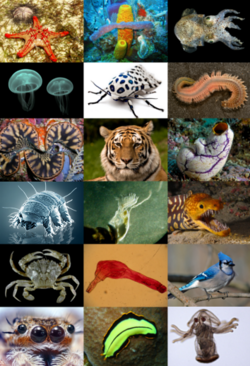
Back Meulatang ACE Dier Afrikaans Tiere ALS እንስሳ Amharic Animalia AN Deor ANG पशु ANP حيوان Arabic ܚܝܘܬܐ ARC حيوان ARY
| Animalia | |||
|---|---|---|---|
 | |||
| Scientific classification | |||
| Domain: | Eukaryota | ||
| Clade: | Amorphea | ||
| Clade: | Obazoa | ||
| (unranked): | Opisthokonta | ||
| (unranked): | Holozoa | ||
| (unranked): | Filozoa | ||
| Kingdom: | Animalia Linnaeus, 1758 | ||
| Phyla | |||
| |||
| Synonyms | |||
| |||
Animals (or Metazoa) are living creatures with many cells that make up the kingdom Animalia.
Animals get their energy from other living things. Usually, they eat them or are parasites. Animals, plants, fungi, and some other living things have complex cells, so they are grouped together as eukaryotes.
The study of animals is called zoology.[1][2][3] The study of ancient life is called palaeontology.
Most animals are mobile, meaning they can move around. Animals take in oxygen, and give out carbon dioxide.[4] This cellular respiration is part of their metabolism (chemical working). In both these ways they are different from plants. Also, the cells of animals have different cell membranes to other eukaryotes like plants and fungi.
Plants are also multicellular eukaryotic organisms, but live by using light, water and basic elements to make their tissues.
- ↑ Alexander, R. McNeill 1990. Animals. Cambridge University Press. Cambridge. ISBN 0-521-34865-X
- ↑ Ville C.A; Walker W.F. & Barnes R.D. 1984. General zoology. Saunders
- ↑ Hamilton, Gina. Kingdoms of life – Animals. Lorenz Educational Press. ISBN 978-1-4291-1610-7
- ↑ Cresswell, Julia 2010. The Oxford Dictionary of word origins. 2nd ed, New York: Oxford University Press. ISBN 978-0-19-954793-7 'having the breath of life', from anima 'air, breath, life'.